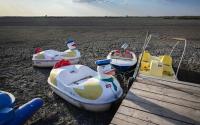20 September 2005Michelle Spitzer
Rapidly strengthening Hurricane Rita lashed the Florida Keys on Tuesday and headed into the Gulf of Mexico, where forecasters feared it could develop into another blockbuster storm targeting Texas or Louisiana.
Thousands of people were evacuated from the Keys and low-lying areas of northern Cuba. On the far side of the Gulf of Mexico in Texas, Galveston started evacuations and officials made plans to move refugees from Hurricane Katrina who had been housed in the Houston area to Arkansas.
Forecasters said Rita could intensify in the Gulf of Mexico into a Category 4 storm with winds of at least 131 mph. The most likely destination by week's end was Texas, although Louisiana and northern Mexico were possibilities, according to the National Hurricane Center.
Acting FEMA Director R. David Paulison told reporters that the agency has aircraft and buses available to evacuate residents of areas the hurricane might hit. Rescue teams and truckloads of ice, water and prepared meals were being sent to Texas and Florida.
"I strongly urge Gulf coast residents to pay attention" to the storm, he said.
Stung by criticism of the government's slow initial response to Hurricane Katrina, President Bush signed an emergency declaration for Florida and spoke with Texas Gov. Rick Perry about planning for the storm's landfall.
"All up and down the coastline people are now preparing for what is anticipated to be another significant storm," Bush said.
Florida Gov. Jeb Bush said more than 2,000 Florida National Guard troops and dozens of law enforcement officers were ready to deal with the storm's aftermath, although it appeared the Keys were spared the storm's full fury.
"I think we did, so far, dodge a bullet," said Key West Mayor Jimmy Weekley.
Rita started the day as a tropical storm with top sustained wind of 70 mph. But as it cruised through the Florida Straits between the Keys and Cuba, it gathered energy from the warm sea, becoming a Category 2 hurricane. By late Tuesday, its top winds had strengthened to 110 mph, just 1 mph away from qualifying as a Category 3 storm.
Bush received a briefing about Rita aboard the USS Iwo Jima, which is docked near downtown New Orleans, as the hurricane caused new anxiety among Katrina victims in Mississippi, Louisiana and Alabama.
"There's still plenty of warm water that it needs to move over in the next couple days. The forecast is favorable for further intensification," said Michelle Mainelli, a meteorologist at the National Hurricane Center.
Residents and visitors had been ordered out of the Keys, and voluntary evacuation orders were posted for coastal mainland areas such as Miami Beach. Some 130,000 people were evacuated in Cuba, on the southern side of the Florida Straits.
Many of Key West's shops and bars were boarded up.
"This city was really very well prepared," said Jim Gilleran, owner of the 801 Bar in the Old Town section of Key West. He kept his business open despite the heavy rain and a power outage.
At least one segment of the Keys highway, U.S. 1, was barricaded because of water and debris, the Florida Highway Patrol said. Wind-driven water was flowing across other sections of the two- and three-lane highway that connects the Keys.
At 11 p.m. EDT, Rita's eye was about 95 miles west-southwest of Key West. The storm was moving west at 13 mph on a track that kept the most destructive winds at sea, the hurricane center said.
Nearly 900 miles from Key West, officials of Galveston were already calling for voluntary evacuations, with mandatory evacuations to begin Wednesday. Louisiana Gov. Kathleen Blanco urged everyone in the southwest part of the state to prepare to evacuate.
Even those who had survived major hurricanes were getting ready to leave. Catherine Womack, 71, was busy boarding up the windows on her one-story brick house in Galveston.
"Destination unknown," she said. "I've never left before. I think because of Katrina, there is a lot of anxiety and concern. It's better to be safe than sorry."
New Orleans Mayor Ray Nagin suspended his plan Monday to start bringing residents back to the city after warnings that Rita could follow Hurricane Katrina's course and rupture his city's weakened levees.
The Pentagon stationed coordinating officers and staff at Tallahassee, Fla., and Austin, Texas, to assist storm preparations and recovery. The USS Bataan, an amphibious assault ship, was off Florida's Atlantic coast near Jacksonville, preparing to follow behind Rita to support relief efforts.
The hurricane lifted crude oil prices more than $1 late Tuesday in electronic trading on the New York Merchantile Exchange, sending futures back above $67 a barrel as workers fled facilities in the Gulf of Mexico.
Katrina destroyed 46 platforms and rigs and significantly damaged 18 platforms and rigs, according to the American Petroleum Institute.
Rita is the 17th named storm of the Atlantic hurricane season, making this the fourth-busiest season since record-keeping started in 1851. The record is 21 tropical storms in 1933. Six hurricanes have hit Florida in the last 13 months.
The hurricane season isn't over until Nov. 30. ___
Associated Press writers Jill Barton in Marathon and Vanessa Arrington in Varadero, Cuba, contributed to this report. ___
On the Net:
National Hurricane Center: http://www.nhc.noaa.gov
http://news.yahoo.com/news?tmpl=story&u=/ap/20050921/ap_on_re_us/rita_12






